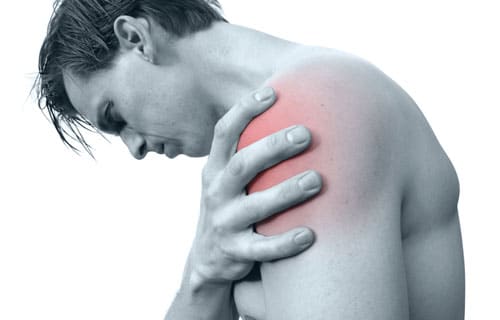Shoulder Bursitis – what is it and how is it treated?
Shoulder bursitis most commonly refers to inflammation of the subacromial bursa, which is a fluid filled sac, that sits at the outer-front aspect of the shoulder. Subacromial bursitis, is one of the most common complaint

s we see in the clinic, and it typically presents as tenderness at the outer aspect of the shoulder, more so when raising the arm, which confines the subcromial space, where the bursa is located. (1)
What is the bursa? Why is it sore?
The bursa is a thin, lubricated cushion, and acts as a barrier at points of friction, between bones and surrounding soft tissue structures. There are about 160 of them around the body, and they vary in size depending on location and the nature of the forces being applied across it. The bursa sac is made up of synovial membrane, which both produces and maintains the synovial fluid within the bursa. (2,3)
The subacromial bursa sits below a bony structure of the shoulder, called the acromion, and provides a cushion barrier between the bone and the rotator cuff muscles that run directly below it. (3)
Bursitis (or inflammation of the bursa), occurs when the synovial membrane becomes inflamed, causing it to thicken and produce an excess of synovial fluid, causing the bursa to swell and become painful. The most common causes for this are excessive friction on the bursa, a direct injury, or an underlying inflammatory condition, such as rheumatoid arthritis. You can also get bone spurs (osteophytes) that grow down from the bottom of the acromion, narrowing the subacromial space that the bursa and rotator cuff tendons sit within. (3)
When the subacromial bursa becomes irritated, it can thicken and cause what it sometimes referred to as Shoulder Impingement Syndrome, which is a painful pinching of the soft tissue structures that sit in the small space between the acromion and the shoulder ball-and-socket joint. This space is call the subacromial space. The tendons of the rotator cuff muscles can also become inflamed, resulting in tendonitis, which contributes to the pain. (4)

How is shoulder bursitis treated?
Most patients generally respond well to a combination of stretches and rehabilitation

exercises provided by their health practitioner, to strengthen the muscles that support and control movement at the shoulder. This helps treat the current bursitis and tendonitis, and minimise the risk of future irritation. Manual therapy techniques including joint mobilisation/manipulation and soft tissue techniques are also often incorporated into most treatment plans.
In the initial phase, rest from activities that are causing aggravation, such as lifting, reaching and overhead work is helpful. Your practitioner can also advise you on activity modification, or changing the way you perform repetitive tasks, in order to reduce irritation on the bursa and tendons. Your doctor may also prescribed you an anti-inflammatory medication to reduce the inflammation and swelling of the bursa. In some cases, a corticosteroid injection (anti-inflammatory) into the bursa, in conjunction with an aspiration (or draining) of the bursa can be beneficial. (5)
Surgery (acromioplasty) may be considered in cases where there is significant bone spurs impinging on the bursa and tendons, that is not improving with conservative treamtment. Surgery will generally include removing part of the acromion and sometimes the bursa itself, such that there is more space for the soft tissue structures. (6)
Will it happen again?
Subacromial bursitis is very common, and can often recur, if the causative factors haven’t been addressed. Most bursae will settle with anti-inflammatories, but it is important to correct postural and movement patterns that are causing it to become aggravated in the first place. If there is significant spurs, and conservative measures are not resolving it, then symptoms will likely recur until this is surgically addressed.
If you are suffering from bursitis, feel free to book a chiropractic appointment at the clinic for a full assessment and appropriate course of treatment.

References:
-
Luime JJ, Koes BW, Hendriksen IJ, Burdorf A, Verhagen AP, Miedema HS, Verhaar JA. Prevalence and incidence of shoulder pain in the general population; a systematic review. Scand J Rheumatol. 2004;33(2):73-81. Review. PubMed PMID: 15163107.
-
van Holsbeeck & Strouse. Sonography of the shoulder: evaluation of the subacromial-subdeltoid bursa. AJR Am J Roentgenol. 1993 Mar;160(3):561-4. PubMed PMID: 8430553.
-
Anastasios Papadonikolakis, Mark McKenna, Winston Warme, Brook I. Martin, Frederick A. Matsen, III; Published Evidence Relevant to the Diagnosis of Impingement Syndrome of the Shoulder. The Journal of Bone & Joint Surgery. 2011 Oct;93(19):1827-1832.
-
National Institute of Arthritis, Musculoskeletal and Skin Diseases, “Shoulder Problems.” May 2010. Accessed March 8, 2012. http://www.niams.nih.gov
-
Codsi MJ. The painful shoulder: when to inject and when to refer. Cleve Clin J Med. 2007 Jul;74(7):473-4, 477-8, 480-2 passim. Review. PubMed PMID: 17682625.
-
Donigan JA, Wolf BR. Arthroscopic subacromial decompression: acromioplasty versus bursectomy alone–does it really matter? A systematic review. Iowa Orthop J. 2011;31:121-6. PubMed PMID: 22096430; PubMed Central PMCID: PMC3215124.

